by Alex Brown | Feb 27, 2017
How you can take plain old tabletop still life photography and make it extraordinary with some still life light painting.
There’s something magical that happens when you have a still life setup on a tabletop and then all the lights go off. With a flashlight ready, still life photography comes to life when you add light painting.
Light painting is an advanced technique that photographers can use to add emphasis to certain subjects of an image. In order to successfully light paint, you need a tripod, a shutter speed around 15 seconds or longer and some cool subjects. It’s also mandatory that you have a completely dark room.
Still life light painting, or light painting in general, teaches you more about your camera since you have to rely on the touch and feel of your camera in the dark. Check out some more pictures by a master of still life light painting at Harold Ross’ Fine Art Photography website.
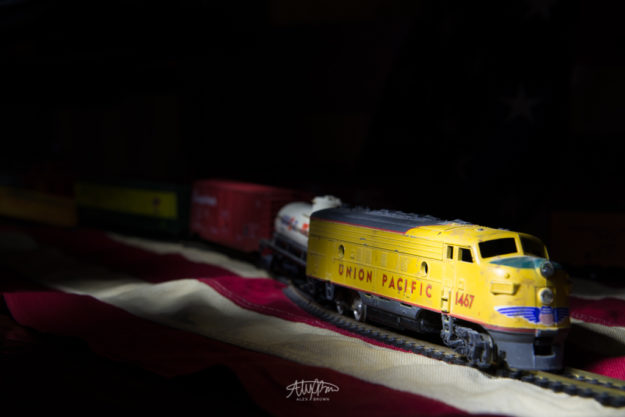
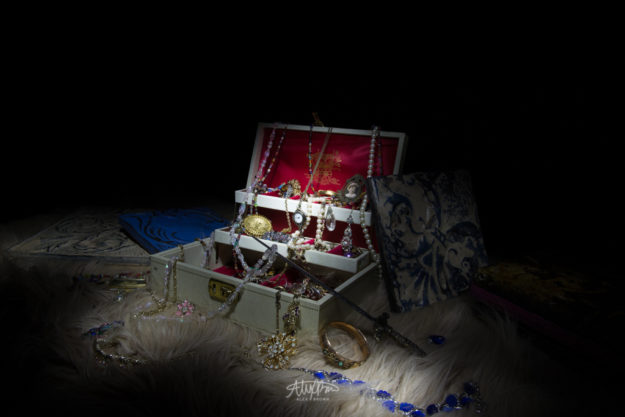
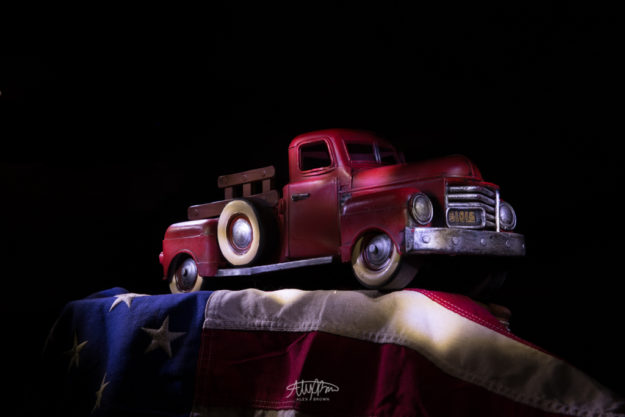
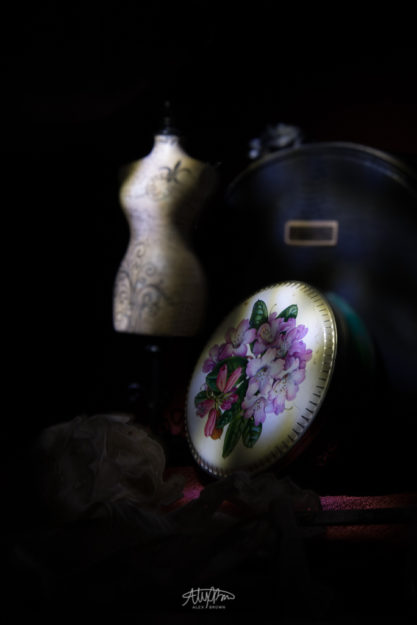
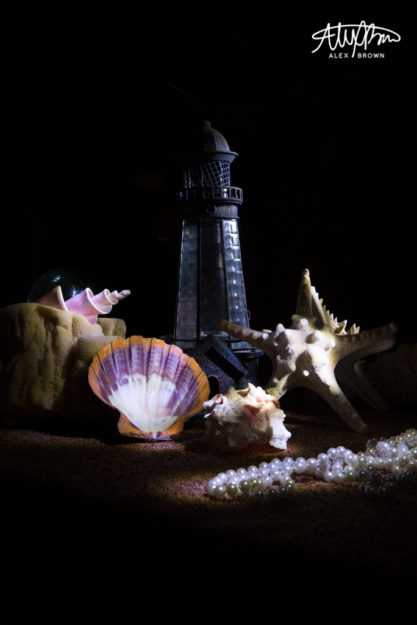
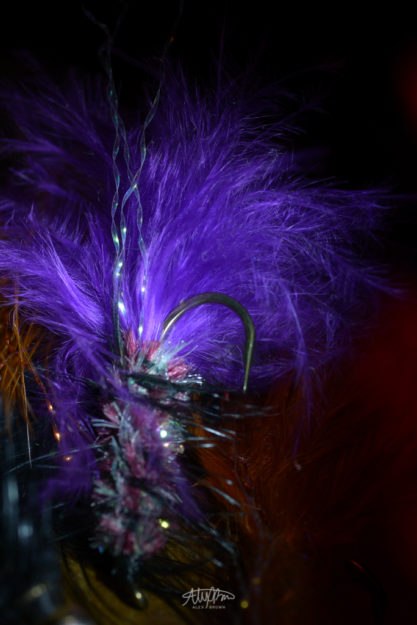
You can still even do light painting with macro!
by Alex Brown | Feb 22, 2017
Fine art photography prints perfect for your home or office that showcase the winter season.
I love winter, especially in Idaho. Coming from North Carolina, we don’t have these beautiful winter, snowy landscapes because we don’t see a whole lot of snow! So being able to take pictures of these beautiful winter landscapes was a real treat for me. All of these fine art prints will be available shortly in my store.
On my photo excursion workshop that I participated in, we stayed at the beautiful Sky Mountain Lodge located in Victor, Idaho. Although it was cloudy most of the time, we stopped everything when the sun came out. While it was out, I was able to get these two beautiful winter landscape shots of the property.
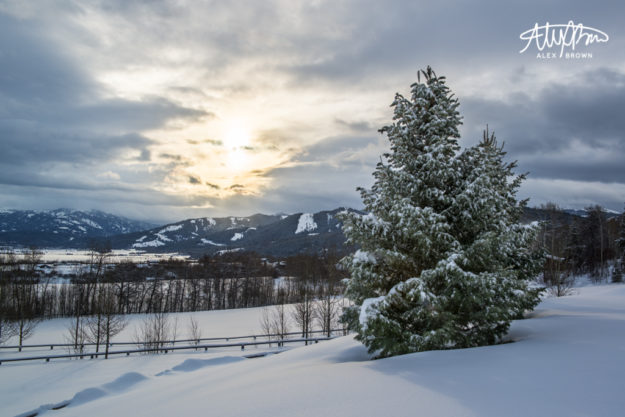
This photography print is an HDR or High Dynamic Range photograph. This fine art print was created by taking the same image and combining three different exposures: one that’s too dark, one that’s too bright and one that is just right. By doing this, all areas in the image are exposed perfectly, details are enhanced and quality is increased.
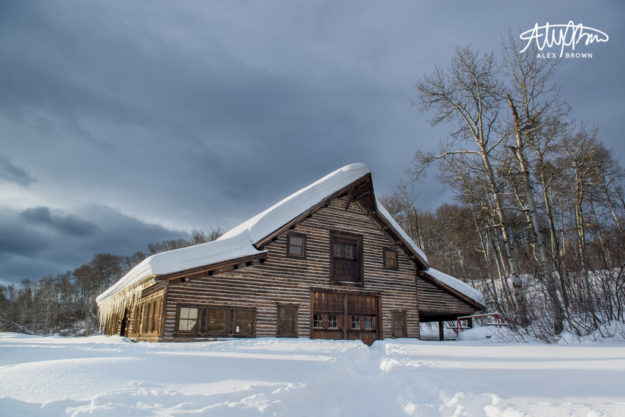
This fine art photography print is also an HDR photograph, creating this beautiful winter barn landscape. To create additional contrast between the pure white snow on top of the barn, I increased the contrast in the clouds. This winter barn landscape would be great in a metal print or with a wood frame that matches the wood on the barn on itself.
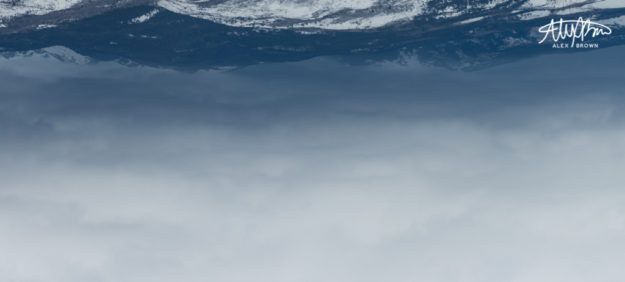
This is for those who enjoy more abstract fine art photography prints. This was taken with a Nikon 70-200mm zoom lens which allowed me to get the mountains on the other side of the lodge. I love the monochromatic color palette in this photograph and the natural gradients in the sky. I then decided to flip this picture horizontally and fell in love with this. I think the reason that this fine art photography print works so well flipped is because it’s softness at the bottom is inviting to the eye. Plus, you can always flip it the other way when you hang it above that big of sectional of yours. 😃
TREES PHOTOGRAPHY PRINTS
These two tree photography prints were actually inspired by some of my fondest travel memories. Often times on vacations or in travels, I will stay at the Hampton Inn by Hilton. I love how art consulting firm Artonomy has created something iconic for Hampton out of something simple and clean: black and white images. No matter what Hampton Inn Lobby you step foot into, three black and white images hang in the foyer and behind the front desk that “best communicate {the areas} local flavor.”
Images are also intended to spur conversation between team members and guests about local favorites. – Hampton Inn Brand Style Guide
One thing that I’ve always admired most about living in Idaho is the beautiful Aspen trees. With this in mind, I wanted to create that same conversational style that Hampton Inn has created with their black and white images and apply it to the area in which the photo excursion took place at — the Idaho Mountains.
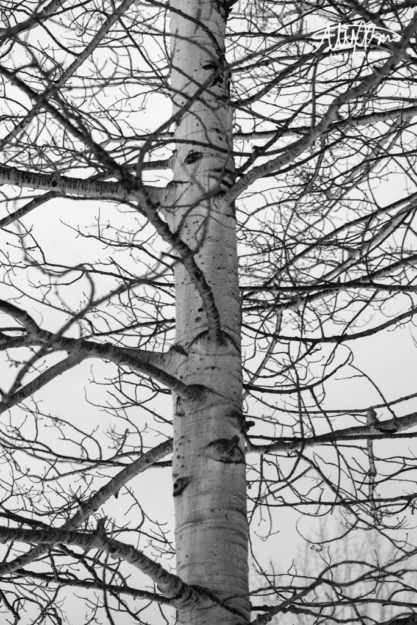
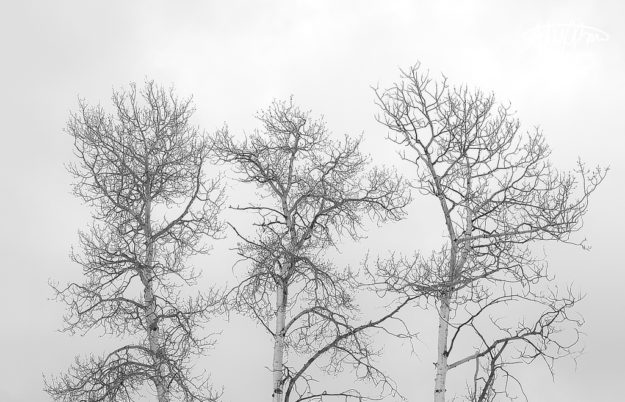
DON’T CLOSE THAT SHUTTER YET…
View some beautiful photography prints by the famous Ansel Adams
-CAB
by Alex Brown | Feb 22, 2017
How a trip to Grand Teton National Park ended with no sunrise or sunset… just simple winter photography.
On my recent photo workshop trip, we woke up at 4:30am and made our way from the Sky Mountain Lodge in Victor, Idaho through Jackson, Wyoming into Grand Teton National Park.
Our intention was to get a beautiful sunrise featuring alpenglow of the majestic Teton mountains. Alpenglow occurs when the tips of the mountains are glowing bright orange – a result of the sun that has already slipped over the horizon. For the Teton mountains, alpenglow occurs minutes before the official sunrise.
So instead of getting shots of a white snow-covered mountain contrasted with the bright colors of sunrise, I embraced the white canvas of the snow covered land capturing simple winter photography.
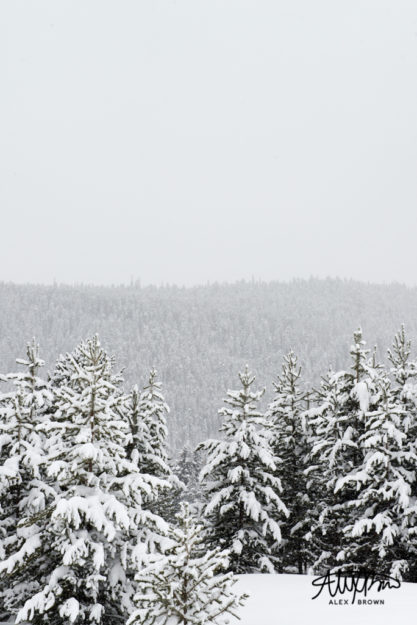
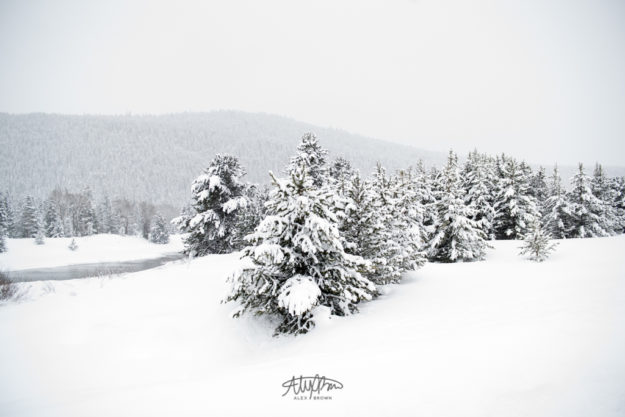
Most of my photos for this post are black and white. The reason I changed them into black and white was because I felt with what little color was present in the picture became a distraction… this is simple winter photography after all.
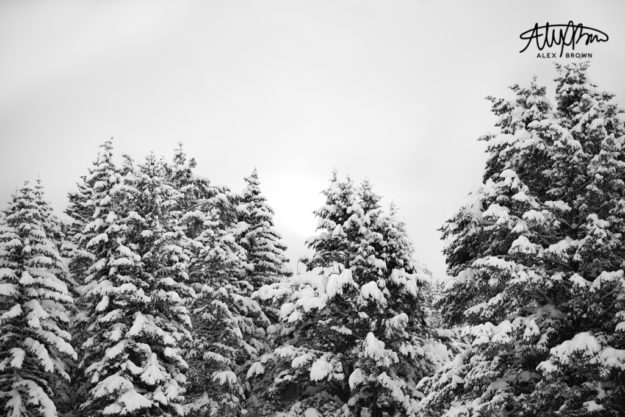
Composition is key when it comes to simple winter photography. Anyone can take pictures of snowy trees with a winter landscape behind them, but what makes the difference is the composition. Always have your horizon lines on the rule of thirds. Or better, find different more intriguing ways for this, such as diagonal alignment.
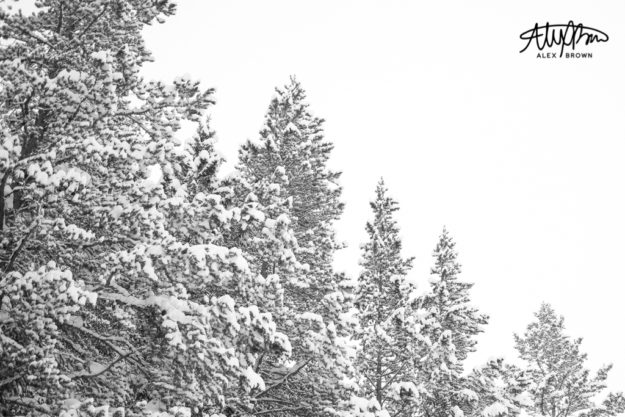
While in Jackson, Wyoming, we were visiting local fine art photography galleries, but were interrupted by two moose in the town square. While some of our photographers got yelled at by bystanders for getting too close, I got this awesome shot which sums up Jackson Tourism: Wildlife photography.
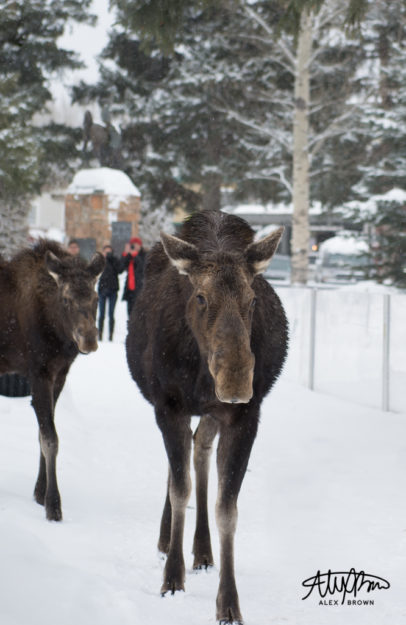
DON’T CLOSE THAT SHUTTER YET…
-CAB
by Alex Brown | Feb 22, 2017
How to photograph the night sky and get amazing long exposure star pictures – even if it’s cloudy.
This past presidents day weekend, I was able to rent two lenses for my Nikon Full-Frame D600. I have already used Nikon’s 70-200mm f/2.8 lens before, but I was most excited to try out Rokinon’s Ultra Wide Angle 14mm f/2.8. Rexburg, Idaho is located one hour west of the Teton Mountain range so our weather is beyond bipolar, it’s straight up strange, which isn’t the best for photographing the stars with night sky photography.
Most people would think that in order to get an awesome night sky photograph, the weather conditions have to be clear. Based upon your personal style, this might be true, but when it comes to night sky photography, I love being able to see the wispiness of the clouds – a natural bi-product of long exposure and night sky photography. However, what I didn’t know was if the clouds are thin enough, you can see through and get stars, like this beautiful night sky photography below!
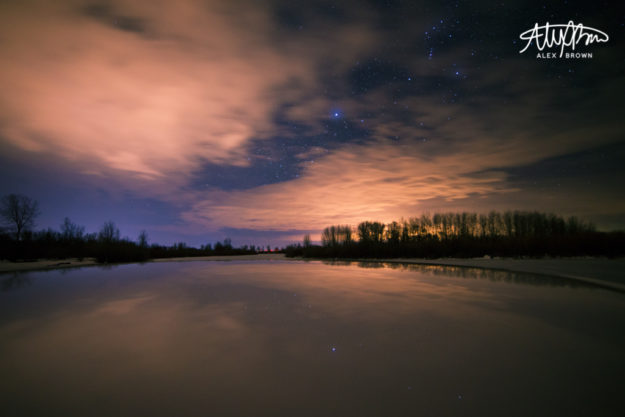
LESSON 1: BALANCING THE LIGHT
Key Tip: If you take a night sky photograph and it’s too bright, always start by dropping down your ISO as you will end up with a less noisy image. If it’s still too bright, decrease your aperture (choose a higher f/number). Also, if the moon is out start with ISO 100.
I took this night sky photo about 5-8 miles outside of Rexburg city limits in a local park at around 10:30pm… so not sunset! I love this photo because it showcases one of the most important aspects when it comes to night sky photography: light pollution. Light pollution is the worst enemy to night sky photography (besides thick cloud decks and the moon).
When your camera shutter is open for a lengthy period (15 seconds in this instance), it has all that time to collect the information, light, and create the pixels for the photograph. When combined with a wide aperture (low f/number) and a high ISO, night sky photography often becomes white sky photography, because it’s not only collecting the natural light from the city or the pollutant’s area, you’ve told the camera to add in more light while being more sensitive to light!
The settings for this night sky photograph were ISO 2000, 15 seconds @ f/3.2, 14mm. When I took this picture, I couldn’t figure out where this light source was coming from, but I did know that it was just too bright for my settings, so I adjusted accordingly.
I loved looking at this gallery of Giovanna Griffo’s Incredibly Stunning Night Sky Photography. Think about how much practice and skill it takes when it comes to balancing the light by adding in the foreground elements.
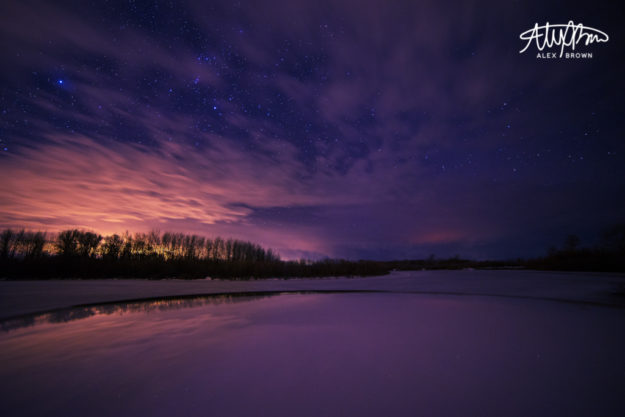
LESSON 2: EDITING THE NIGHT SKY IS REQUIRED.
Key Tip: Use curves in Photoshop or Lightroom to adjust your night sky photograph, bringing out different colors. Go a step further by masking out only certain aspects of the image.
I think the image above is a pretty spectacular night sky photograph on its own. But what if it went on a date and married Photoshop and Lightroom? Well, let’s say that they make good-looking kids.
The first image I showed you was edited “naturally”. This is a term that I personally coined when it comes to night sky photography and basically it means that any edits made – specifically with color – are not as powerful and are more realistic to what the scene was really like. But, it doesn’t hurt to go a step beyond either.
When editing night sky photography, it’s best to use the curves panel and adjustment masks to get color where you want it and when you want it on your image. But don’t just use the RGB curves… use the individual Red, Green and Blue Channel curves when editing night sky photography. Why? It gives you more control over your color and when combined with masks you are able to hide and reveal certain areas of the image. On this picture above, I actually kept the color of the light-polluted clouds from the camera because the transition to the purple hues was less harsh.
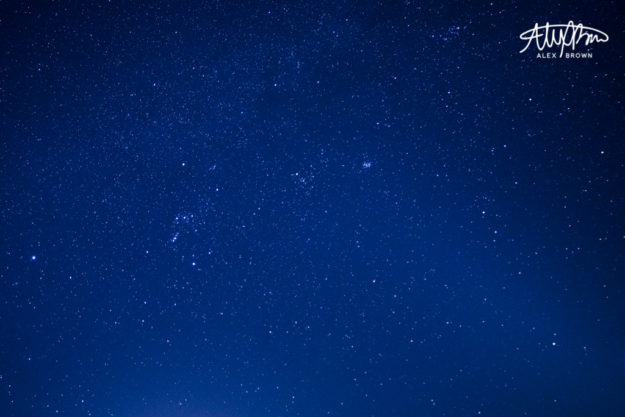
LESSON 3: FOCUS ISN’T FREE, IT’S FOUND
Key Tip: It’s okay if you forget to focus ahead of time… just know that it’ll take a bit longer to get a good focus on the night sky. Also, you don’t always have to use a tripod… look for other objects that you can set your camera on that would create and add interest.
With night sky photography, you don’t necessarily have to use a tripod. For the first two images on this post, I set my tripod on top of my white car. By doing this it gave it a nice surface to reflect off of and it almost looks like it’s a thawing lake. Sorry if I had you fooled.
Having sharp and clear stars is the primary goal of any night sky photographer. While there are different methods on how to properly focus the night sky, my favorite is trial and error. While each camera and lens is different, the best thing is to start with infinity on the focus ring, and work your way until you get nice tack-sharp stars. Once you get that, always remember that because it makes focusing easier on other star trips.
Focusing stars is kind of a two-fold system with night sky photography. The second part of this system is sharpening. Always make sure you sharpen your stars image as it will bring out the detail of even more stars — stars you thought weren’t even in the night sky! But remember… no amount of post-production sharpening can make a blurry image sharp! If you’re a photographer and you’ve never taken a blurry image, I’d love to meet you and learn your secret!
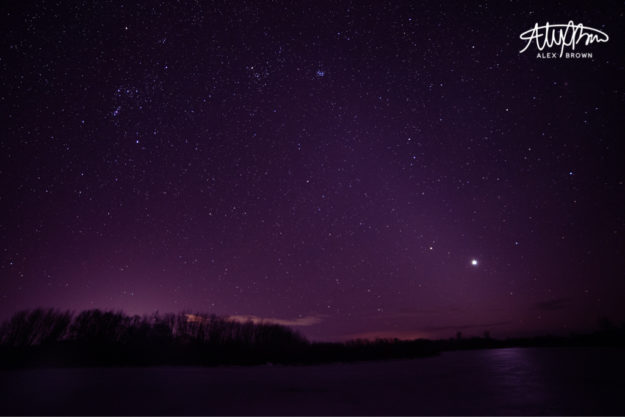
DON’T STOP THE SHUTTER YET…
Here are my other three top picks when it comes to Night Star Photography
Dave Morrow’s Nigh Sky Photo Tutorial on 500px ISO
Alysa Bajenru’s Begginer’s Guide to Night Sky Photography
Popular Photography’s How-To: Shoot Epic Night Sky Landscapes
-CAB
by Alex Brown | Feb 15, 2017
Some inspiration for those trying to make sense of Macro Photography
Macro photography is always super fun but is crazy ridiculous to shoot because you have to keep so still!
When shooting macro photography, there are three main ways that you are able to nail getting sharp water drops on flowers, still life or even a dead fly.
- Dedicated macro lens – it’s best to have one that is around 85mm – 120mm… 100mm is the best focal length.
- Macro Extension Tubes – The purpose of macro extension tubes is to extend the distance of your lens to the subject. Macro extension tubes are my favorite to shoot with!
- Macro Close-up Filters – Macro close-up filters are lens filters that screw onto the front of your lens and magnify the area. They come in different strengths. I personally am not a fan of using close-up filters when it comes to macro photography because it produces some distortion and chromatic aberration.
With my macro extension tubes locked and loaded, I tackled the world of macro photography, one water drop at a time.
FLORA/FAUNA
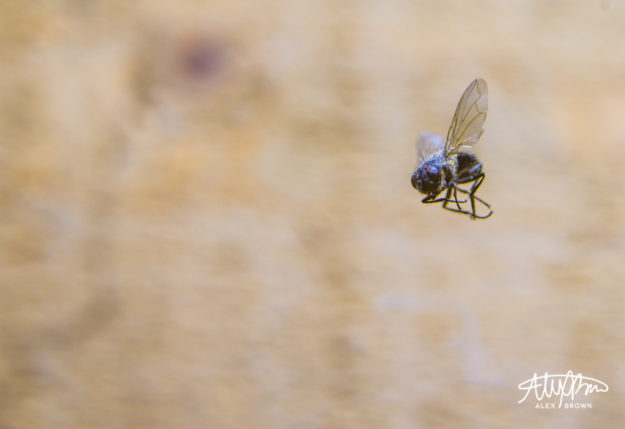
This fly was actually trapped in a spider’s web! I love this macro photograph because you can see the small details on his antennae in addition to the delicacy of the wing structure. Plus he kinda looks like a wasp springing into action.
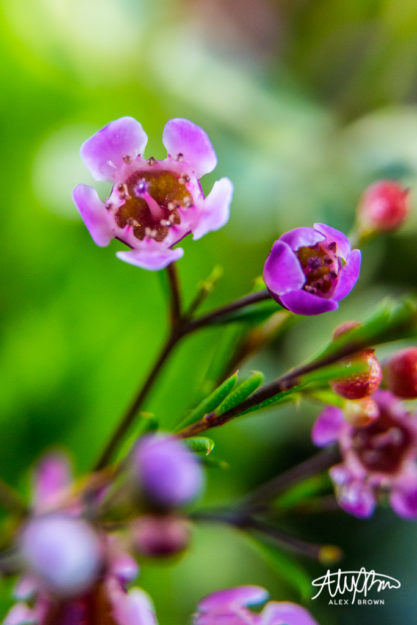
This is one of my favorite shots on this macro photography run! I love how there is a variety of depths, focus and colors in this picture. You have the beautiful foreground blurring and nice shallow depth of field that then sweeps into a nice sharp macro photograph of the violet and pink flower. Furthermore, I love the red berries off to the right because they’re so unexpected!
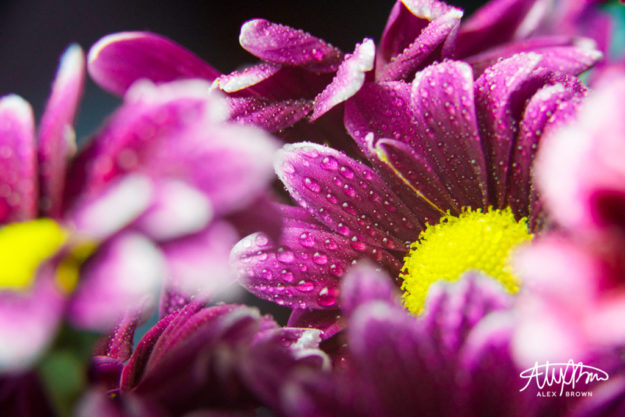
When you frame your subject you not only create interest but you also help showcase your focal point. With macro photography, bokeh and shallow depth of fields come naturally and when combined with framing your subject, you get a beautiful macro photograph thanks to the dynamic duo!
Check out these 55 Beautiful Macro Flower Pictures!
WET WITH WATER
Macro photography is ten times better when you involve water and water drops! When you involve water drops in macro photography one of two effects can be created:
- Fisheye-like lens: The water drop acts like a fisheye lens as it magnifies whatever’s in front of it (whether you put it there or not!)
- Morning Dew: Depending on how much water you add, the water drops can become like the morning dew
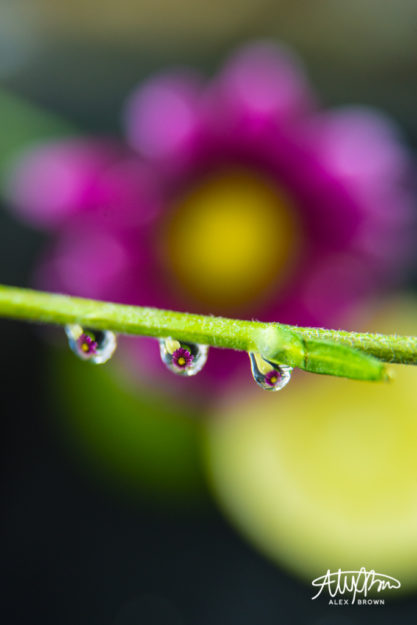
This macro photograph is a fisheye of a beautiful flower with a lime next to it.
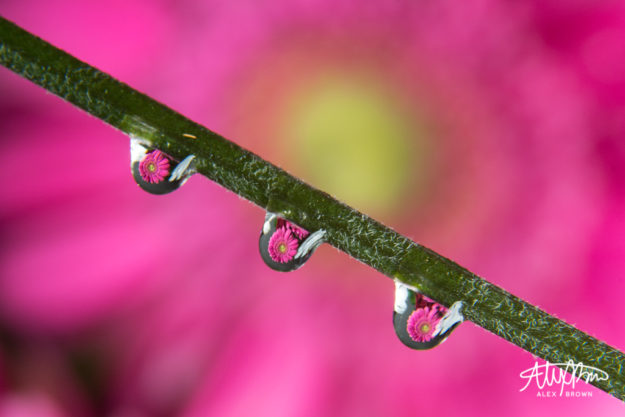
I love the composition of this macro photograph because of how the stem is diagonally separating the flower, creating TWO focal points! The upper half’s focal point is the yellow center of the flower, while the lower focus point are the fisheye lens water drops!
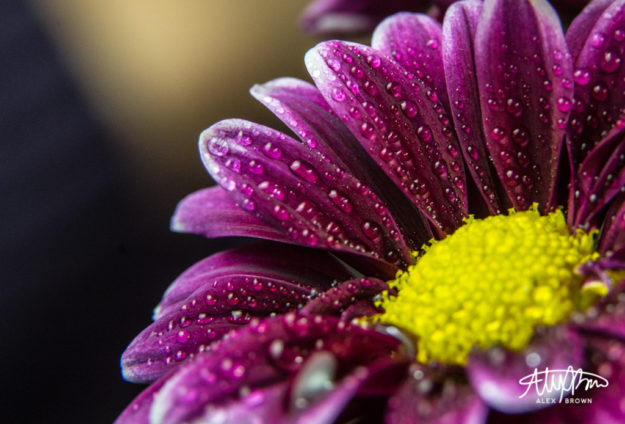
This is a great example of the morning dew effect. The thing that I want to point out in this photograph is the contrast of the neutral colors in the background. The neutral tones help complement the beautiful colors of this flower.
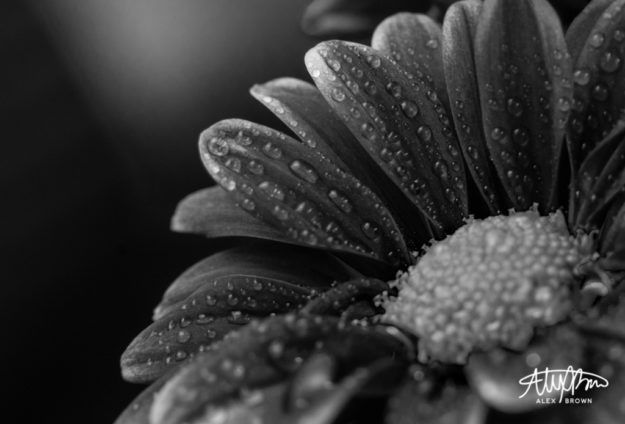
Macro is great for Black and White. I love how the mood completely changes when compared to the color!
ABSTRACT AND STILL LIFE
Abstract art is one of my favorite things to create with photography. I love how macro photography allows you to take every day objects and find different and new perspectives!
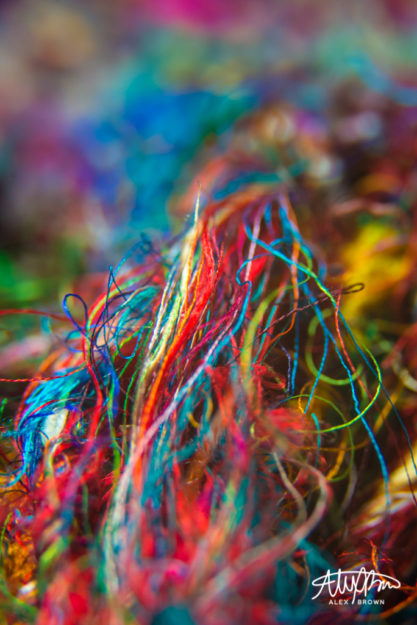
Macro photograph of threads from a knitted scarf. I love how colorful this is and how the leading lines lead you into the bokeh!
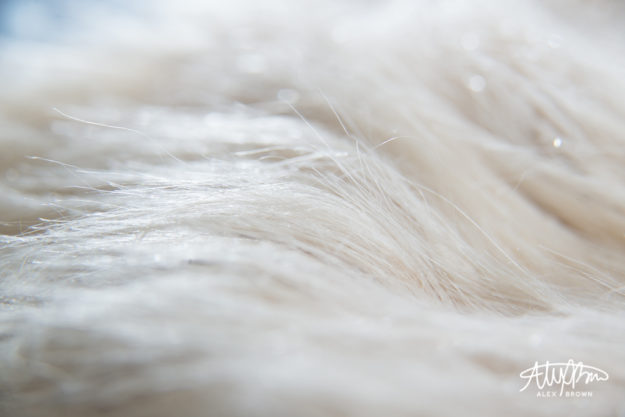
The fine threads in this fur combined with the light blue in the background create beautiful abstract waves!
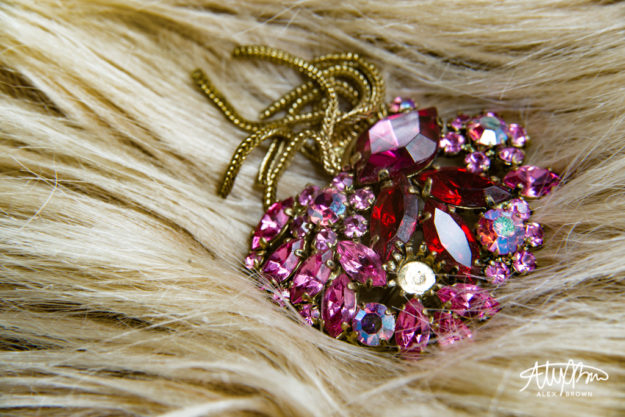
Macro photography also produces awesome results when you involve a contrast of textures! The beautiful shine of the broach against the blonde fur (it really is fur) is beautiful!
by Alex Brown | Feb 15, 2017
SOME INSPIRATION FOR THOSE TRYING TO MAKE SENSE OF MACRO PHOTOGRAPHY
Macro photography is always super fun but is crazy ridiculous to shoot because you have to keep so still!
When shooting macro photography, there are three main ways that you are able to nail getting sharp water drops on flowers, still life or even a dead fly.
- Dedicated macro lens – it’s best to have one that is around 85mm – 120mm… 100mm is the best focal length.
- Macro Extension Tubes – The purpose of macro extension tubes is to extend the distance of your lens to the subject. Macro extension tubes are my favorite to shoot with!
- Macro Close-up Filters – Macro close-up filters are lens filters that screw onto the front of your lens and magnify the area. They come in different strengths. I personally am not a fan of using close-up filters when it comes to macro photography because it produces some distortion and chromatic aberration.
With my macro extension tubes locked and loaded, I tackled the world of macro photography, one water drop at a time.
Macro photography is ten times better when you involve water and water drops! When you involve water drops in macro photography one of two effects can be created:
- Fisheye-like lens: The water drop acts like a fisheye lens as it magnifies whatever’s in front of it (whether you put it there or not!)
- Morning Dew: Depending on how much water you add, the water drops can become like the morning dew

This macro photograph is a fisheye of a beautiful flower with a lime next to it.

I love the composition of this macro photograph because of how the stem is diagonally separating the flower, creating TWO focal points! The upper half’s focal point is the yellow center of the flower, while the lower focus point are the fisheye lens water drops!

This is a great example of the morning dew effect. The thing that I want to point out in this photograph is the contrast of the neutral colors in the background. The neutral tones help complement the beautiful colors of this flower.

Macro is great for Black and White. I love how the mood completely changes when compared to the color!






























